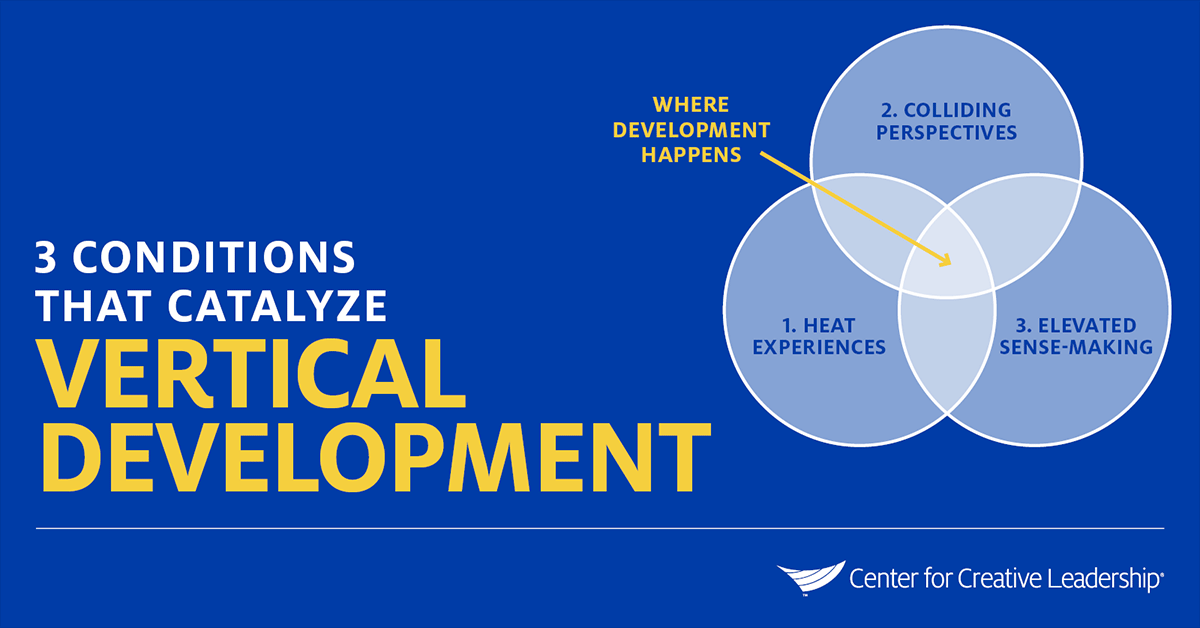Both Horizontal & Vertical Development Are Important
What kind of thinkers do you need in your business? What types of leadership will get you desired results?
To answer these questions, you’ve got to be thinking about a different kind of learning and development. Yes, you want to ensure that HR is preparing a pipeline of leaders for the future. But how exactly are you doing that?
Your organization needs both horizontal and vertical development to get you there.
First, What’s the Difference Between Horizontal vs. Vertical Leadership Development?
When we say horizontal development, we mean the traditional kind of talent development: increasing technical skillsets and building the most important leadership competencies. If your organization is like most, you’re probably already providing all sorts of opportunities for horizontal development — disseminating more knowledge, skills, and information to your people. These skills are essential and necessary — but they are no longer sufficient in our new era.
In contrast, vertical development is entirely different. What is it exactly?
Vertical development is about developing more complex and sophisticated ways of thinking, greater wisdom, and clearer insights. It’s called vertical development because it’s based on levels, or stages, of thinking. It involves gaining new perspectives and leadership mindsets needed to make your business strategy work.
For example, with vertical development, managers and groups learn to tackle a problem with inquiry — questions, observation, and reflection — before jumping into advocating, lobbying, or deciding. This opens the door to deeper understanding, greater clarity, more options, and multiple right answers — which are especially needed for leading in complex, uncertain situations.
In short, horizontal development builds skills, while vertical development helps build a more interconnected, interdependent leadership culture in your organization.
What Is Vertical Development?
3 Conditions That Catalyze Vertical Development for Leaders
Our research has found that these 3 primary conditions support vertical leadership development:
- Heat experiences;
- Colliding perspectives; and
- Elevated sense-making.
Many well-intentioned leadership development programs fail to deliver lasting results because they hit on only 1 or 2 of the conditions needed for vertical development. And any one of the above can provide some value, but it’s not until you combine all 3 that you have vertical development, and growth really takes off. Let’s take a closer look at each of these 3 conditions.
Heat Experiences: The What
Leaders have the opportunity to respond to heat experiences when they face a complex situation that disrupts and disorients their habitual way of thinking. These situations help leaders discover that their current way of making sense of the world is inadequate. As a result, they seek out new and better ways to make sense of their challenge. Heat experiences are the what that initiates vertical development. Learn more about how to harness heat experiences for development.
Colliding Perspectives: The Who
Leaders also have an opportunity to challenge their existing mental models when they’re exposed to others with different worldviews, opinions, backgrounds, and training. These relationships increase the number of perspectives through which leaders experience their world. Colliding experiences are the who that enables vertical development.
Elevated Sense-Making: The How
As leaders process and make sense of these perspectives and experiences, they enter an elevated stage of vertical development. A larger, more advanced worldview emerges and, with time, stabilizes. This is the how that integrates development, particularly when preparing high-potential leaders for the unknown.
Is Your HR Function Focused on Both Horizontal & Vertical Development?
Some Questions to Ask
Are both horizontal and vertical development factored into how your HR function thinks about your talent, your culture, and how people learn and grow? Consider these questions about the perspectives of your Human Resources or Organizational Development functions:
- Does our organization understand the difference between horizontal vs. vertical development? Are both horizontal and vertical development incorporated strategically into our leadership development methods and approach?
- Is our organization aligning our leadership culture to our strategy? Organizational leadership cultures develop through different stages: dependent, independent, and, eventually, interdependent. Has our team worked out which leadership culture our strategy requires? Are we designing leadership development to match?
- Do we have a good understanding of how leaders make different sense of the world at each of the stages? Whether explicitly or implicitly, is this understanding blended into the way we develop our leaders?
Learn more about how vertical development and organizational culture change are interconnected in our white paper, Vertical Leadership Development: Culture Still Wins Over Strategy.
HR’s Role: Tailoring Development, Both Horizontal & Vertical
Remember, employees come into their roles with different experiences, skills, perspectives, and stages of development. Human Resources must put experience at the center of talent management, tailor development, and meet people where they are — as not everyone is ready for the same challenges at the same time.
For example, you may emphasize horizontal development for your early-career talent, but you can plant the seeds for vertical development for them, too. Learning from heat experiences, experiencing colliding perspectives, and helping elevate their sense-making can support frontline leaders through many of the common challenges that first-time managers face.
And for experienced executives, senior leaders need different leadership skills, so their process of vertical development will likely be more complex and collaborative — but their mindsets or approaches may be more fixed.
There’s an important difference between helping a leader grow and trying to force it, though. At each stage of development, both horizontal and vertical development are important. The role of HR is to create the right conditions in which many different people can grow and develop.
Ready to Take the Next Step?
Partner with us for both horizontal and vertical development that’s tailored to your organization’s unique context and culture. Learn more about our talent development solutions.












